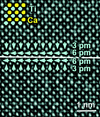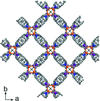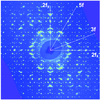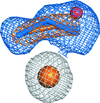issue contents
July 2016 issue

editorial
MATERIALS | COMPUTATION
Articles published recently in IUCrJ continue to exemplify the developments and challenges in the structural science of materials.
scientific commentaries
BIOLOGY | MEDICINE
Serial crystallography at a synchrotron has been used to obtain time-resolved atomic resolution density maps of enzyme catalysis in copper nitrite reductase. Similar XFEL studies, intended to out-run radiation damage, will also soon appear.
MATERIALS | COMPUTATION
Higher-dimensional structure analysis of quasicrystals is now possible. Yamada et al. [IUCrJ (2016), 3, 247–258] have solved the atomic structure of icosahedral ScZn7.33 including the characteristic imperfections.
research papers
CHEMISTRY | CRYSTENG
Download citation


Download citation


Reported here are the isolation and direct observation of extremely reactive S2 and its conversion into bent-S3 via a cyclo-S32+ intermediate on interactive sites in porous coordination networks.
MATERIALS | COMPUTATION
A charge-density model of urea was calculated using quantum theory and was refined against publicly available ultra-high-resolution X-ray diffraction data. The quantum model differs from a multipole model but agrees comparably with the data; quantum crystallography therefore can provide unique and accurate charge density models.
MATERIALS | COMPUTATION
Download citation


Download citation


The detailed atomic structure of the binary icosahedral ScZn7.33 quasicrystal has been investigated by means of high-resolution synchrotron single-crystal X-ray diffraction and absolute scale measurements of diffuse scattering.
CCDC reference: 1476647
BIOLOGY | MEDICINE
Residue-contact predictions extend the range of ab initio molecular replacement.
BIOLOGY | MEDICINE
Download citation


Download citation


Serial crystallography has been used to drive copper nitrite reductase through its enzymatic cycle while sampling the same volume of a single cryogenically maintained crystal. A structural movie of X-ray-driven enzyme catalysis has thus been obtained, revealing the structural changes that occur during the catalytic reaction in unprecedented detail.
PDB references: nitrite reductase, ds1, 5i6k; ds4, 5i6l; ds11, 5i6m; ds17, 5i6n; ds30, 5i6o; ds40, 5i6p
BIOLOGY | MEDICINE
Download citation


Download citation


This article presents the features and structures of protein crystals naturally grown in vivo within developing embryos of the only known viviparous cockroach, D. punctata. This study reveals the heterogeneous nature of the crystalline protein with respect to amino-acid sequence, glycosylation and bound fatty acid at atomic resolution.



 journal menu
journal menu




 access
access






















